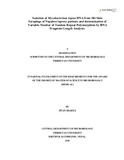Please use this identifier to cite or link to this item:
https://elibrary.tucl.edu.np/handle/123456789/606| Title: | Isolation of Mycobacterium Leprae Dna From Slit Skin Scrapings of Nepalese Leprosy Patients and Determination of Variable Number of Tandem Repeat Polymorphism by Dna Fragment Length Analysis. |
| Authors: | Shakya, Jivan |
| Keywords: | Leprosy;VNTR polymorphisms;Slit Skin Scraping |
| Issue Date: | 2010 |
| Publisher: | Central Department of Microbiology |
| Institute Name: | Central Department of Microbiology |
| Level: | Masters |
| Abstract: | Nepal is a leprosy endemic country. Global standard methods to decipher Mycobacterium leprae strain information have been based on VNTR polymorphisms detected by DNA sequencing and DNA fragment length analysis (FLA). Herein, DNA fragment length analysis was employed to detect polymorphisms at 18 different VNTR loci within Nepalese M. leprae isolates. 40 slit skin scraping (SSS) samples from MB patients used routinely for diagnosis of leprosy were collected for M. leprae DNA isolation. Each DNA sample was then amplified by multiplex-PCR in four combinations containing different primer pairs of 18 different VNTR loci. The VNTR loci amplified in this study were (AC)8b, (GTA)9, (GGT)5, (AT)17, rpoT (6-3a), 21-3, (AC)9, (AT)15, (AC)8a, ML01, 27-5, 6-7, (TA)18, (GAA)21, 18-8, 12-5, 23-3 and (TA)10. The lengths of the amplicons were then analyzed by DNA fragment analysis to determine the correct number of repeat units at each of the VNTR loci. The consolidated data on each M. leprae isolate was then used to classify 40 M. leprae isolates into various clusters of similarity. DNA was successfully isolated from SSS samples. The A ratio ranged from 0.83 to 1.45 and the yield ranged from 10.1 µg/ml to 265.5 µg/ml. Preliminary data on VNTR polymorphisms from 40 samples indicated that locus rpoT was considerably stable in Nepal with repeat copy number 3. 260/280 (TA)18 and (AT)15 were the most polymorphic of all and showed 12 and 11 different alleles correspondingly. In general, minisatellite loci were found to be more stable than microsatellite loci. Based on the similarity of VNTR patterns, the 40 M. leprae isolates could be separated into four major clusters and four unique strains. In one instance, the samples from the same family showed similar patterns at the VNTR loci. These results indicate that these methods can be used for strain typing of Nepalese M. leprae isolates according to globally recognized standards. Key Words : Leprosy, M. leprae, Variable Number of Tandem Repeats (VNTR), Multiplex-PCR, DNA Fragment Length Analysis, Slit Skin Scraping, VNTR polymorphisms, Strain typing. |
| URI: | http://elibrary.tucl.edu.np/handle/123456789/606 |
| Appears in Collections: | Microbiology |
Files in This Item:
| File | Description | Size | Format | |
|---|---|---|---|---|
| THESIS.pdf | 2.04 MB | Adobe PDF |  View/Open |
Items in DSpace are protected by copyright, with all rights reserved, unless otherwise indicated.
